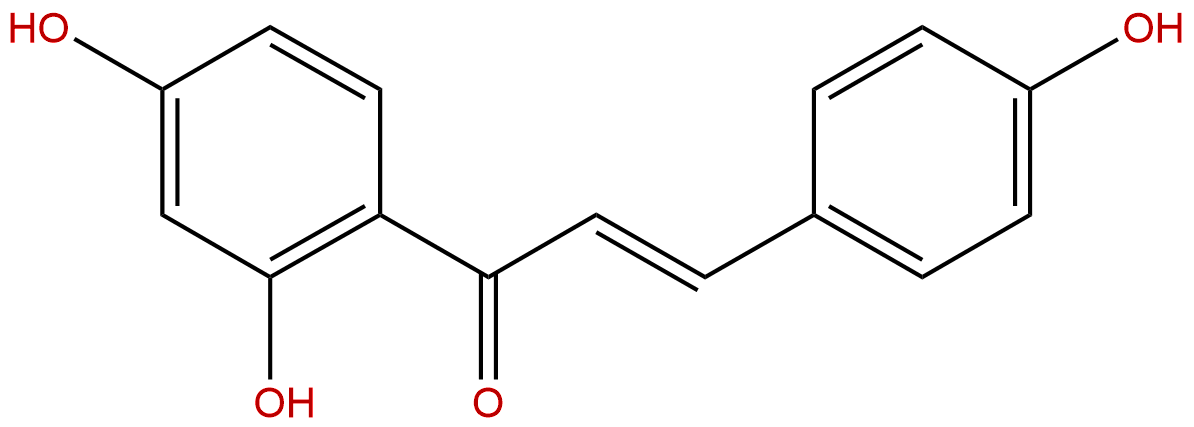
IsoliquiritigeninCAS No.:961-29-5
|
||||||||||
 |
|
|
||||||||

| Catalogue No.: | BP0787 |
| Formula: | C15H12O4 |
| Mol Weight: | 256.257 |
Product name: Isoliquiritigenin
Synonym name:
Catalogue No.: BP0787
Cas No.: 961-29-5
Formula: C15H12O4
Mol Weight: 256.257
Botanical Source: Acacia spp., Allium chinense (rakkyo), Bauhinia manca, Broussonetia papyrifera infected with Fusarium solani f. mori, Cleome viscosa, Cyclolobium spp., Dahlia tenuicaulis, Dahlia variabilis, Dalbergia spp., Glycyrrhiza sp.,
Physical Description: Yellow powder
Type of Compound: Chalcones
Purity: 95%~99%
Analysis Method: HPLC-DAD or/and HPLC-ELSD
Identification Method: Mass, NMR
Packing: Brown vial or HDPE plastic bottle
Storage: Store in a well closed container, protected from air and light. Put into refrigerate or freeze for long term storage.
Whenever possible, you should prepare and use solutions on the same day. However, if you need to make up stock solutions in advance, we recommend that you store the solution as aliquots in tightly sealed vials at -20℃. Generally, these will be useable for up to two weeks.
The product could be supplied from milligrams to grams, up to kilograms
Inquire for bulk scale.
Descriptions:
Isoliquiritigenin(ILTG), a flavonoid constituent in the root of Glycyrrhiza glabra, has vasorelaxant effect, anti-platelet, anti-allergic and antiviral activities, also has protective effects in transient middle cerebral artery occlusion-induced focal cerebral ischemia in rats.[1]
Insampaedoksan is a traditional herbal medicine used for antipyretic and antiinflammatory diseases, thus, it has bioactivity effects such as antioxidant, estrogenic and anticancer. [2]
Isoliquiritigenin significantly inhibits the proliferation of prostate and lung cancer cell lines in a dose-dependent and time-dependent manner, suggests that it is a candidate agent for the treatment of prostate、lung cancer and GADD153 may play an important role in isoliquiritigenin-induced cell cycle arrest and cell growth inhibition.[3,4]
Isoliquiritigenin inhibits proliferation and induces apoptosis of U87 human glioma cells in vitro, through cell cycle arrest and the caspase-mediated apoptosis pathway by regulating the expression of specific molecules.[5]
Isoliquiritigenin can inhibit IκB kinase activity and ROS generation to block TNF-α induced expression of cell adhesion molecules on human endothelial cells, these results have important implications for using ILTG or its derivatives towards the development of effective anti-inflammatory molecules.[6]
Isoliquiritigenin has the anti-inflammatory properties, caused by iNOS, COX-2, TNF-α, and IL-6 down-regulation due to NF-κB inhibition via the suppression of IKK, ERK1/2 and p38 phosphorylation in RAW 264.7 cells.[7]
Isoliquiritigenin has the ability to protect cells from AA+iron-induced H2O2 production and mitochondrial dysfunction, which is mediated with GSK3β phosphorylation downstream of AMPK.[8]
References:
[1] Zhan C, Yang J. Pharmacol Res, 2006, 53(3):303-9.
[2] Lee K J, Jung P M, Roh J H, et al. Asian J Chem, 2014,26(8):24-5.
[3] Kanazawa M, Satomi Y, Mizutani Y, et al. Eur Urology, 2003, 43(5):580-6.
[4] Ii T, Satomi Y, Katoh D, et al. Cancer Lett, 2004, 207(1):27-35.
[5] Zhou G S, Song L J, Yang B. Mol Med Rep, 2013, 7(2):531-6(6).
[6] Kumar S, Sharma A, Madan B, et al. Biochem Pharmacol, 2007, 73(10):1602-12.
[7] Kim J Y, Park S J, Yun K J, et al. Eur J Pharmacol, 2008, 584(1):175-84.
[8] Song H C, Kim Y W, Sang G K. Biochem Pharmacol, 2010, 79(9):1352-62.
[9] Zhao X S, Meng H, Feng J D. Lishizhen Med Materia Medica Res, 2011, 22(4):888-9.
HPLC of Isoliquiritigenin
